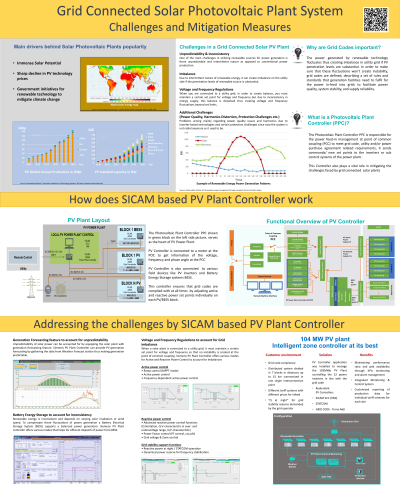Back

Grid Integration
Overview of Grid Connected Solar Plant System: Challenges and Mitigation Measures
Tuesday, September 12, 2023
4:30 PM - 5:30 PM PDT
Location: Poster Area, Booth #11024, Level 1, Venetian Expo Hall


Hura Masroor
Business Development Manager, EA
Siemens Industry
Conroe, Texas, United States
Poster Presenter(s)
Description and Background: Utilization of renewable energy sources (RES) particularly solar energy is going up at an exponential rate in today’s world. The prime reason behind this popularity is the sharp decline in the price of PV modules, government incentives on adopting cleaner source of energy as well as increasing price of petroleum products. While solar power brings massive advantages; it also poses challenges to grid operators. This paper will shed light into all the challenges that are faced while integrating solar plants with utility grid and how we can overcome these threats by use of right technology and tools. It will also discuss recommendations to make solar plant even more productive and efficient by using the latest techniques to improve forecasting of generation and to provide different means for grid stabilization.
When we connect a solar plant with public grid, the first challenge is to comply with grid code requirements that varies depending on the type of utility grid that you are connecting to. Secondly, there are various vendors involved in a solar farm like solar module manufacturers, inverter manufacturers, battery energy storage system providers etc. all with their own characteristics and operating philosophies. Therefore, dynamic simulation models are created to identify the best mix of various sources to come up with a model with high power output, lower CO2 emissions and cost-effective. Solar Plant Controller plays a vital role in making sure that the plant is always complying with grid codes with exceptionally fast response times while also contributing towards longer battery life, for example.
When we connect a solar plant with public grid, the first challenge is to comply with grid code requirements that varies depending on the type of utility grid that you are connecting to. Secondly, there are various vendors involved in a solar farm like solar module manufacturers, inverter manufacturers, battery energy storage system providers etc. all with their own characteristics and operating philosophies. Therefore, dynamic simulation models are created to identify the best mix of various sources to come up with a model with high power output, lower CO2 emissions and cost-effective. Solar Plant Controller plays a vital role in making sure that the plant is always complying with grid codes with exceptionally fast response times while also contributing towards longer battery life, for example.
